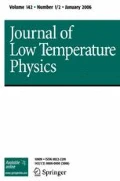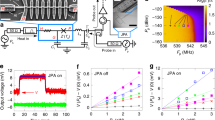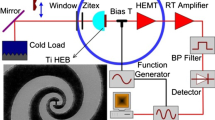Abstract
We introduce the ‘Joule stepping’ technique, whereupon a constantly biased bolometer has its bias voltage modified by a small additional step. We demonstrate this technique using a composite NTD semiconductor bolometer and a pulsing device that sends an extra step in voltage. We demonstrate the results of the technique over a range of bias voltages at 100, 200 and 300 mK. Joule stepping allows us to directly measure long thermal tails with low amplitudes in the response of the global thermal architecture of bolometers and could be a useful tool to quickly and easily calibrate the thermal time response of individual bolometric detectors or channels. We also show that the derivative of the Joule step is equivalent to the bolometer response to a \(\delta \)-pulse (or Joule pulse), which allows for greater understanding of transient behaviour with a better signal-to-noise ratio than pulsing alone can provide. Finally, we compare Joule step pulses with pulses produced by \(\alpha \) particles, finding a good agreement between their fast decay constants, but a discrepancy between their thermal decay constants.




Similar content being viewed by others
References
P.A.R. Ade, N. Aghanim, C. Armitage-Caplan et al., Astron. Astrophys. 571, A10 (2014). https://doi.org/10.1051/0004-6361/201321577
R. Adam, P.A.R. Ade, N. Aghanim, M. Arnaud et al., Astron. Astrophys. 594, A7 (2016). https://doi.org/10.1051/0004-6361/201525844
A. Benoit, F. Zagury, N. Coron, M. De Petris, F.-X. Désert, M. Giard et al., A&AS 141, 3 (2000). https://doi.org/10.1051/aas:2000129
S.L. Stever, Ph. D. thesis (2019), tel-02091039
S.L. Stever, F. Couchot, N. Coron, R.M.J. Janssen et al., Proc. SPIE 10698, 1069863 (2018). https://doi.org/10.1117/12.2313968
S.L. Stever, F. Couchot, N. Coron, B. Maffei, J. Instrum. 14(01), P01012 (2019). https://doi.org/10.1088/1748-0221/14/01/P01012
R.M.J. Janssen, S.L. Stever, V. Sauvage, G. Rouille et al., Proc. SPIE 10709, 107091V (2018). https://doi.org/10.1117/12.2311686
M. D’Andrea, A. Argan, S. Lotti, C. Macculi et al., Proc. SPIE 9905, 9055X (2016). https://doi.org/10.1117/12.2231412
Acknowledgements
The author wishes to acknowledge CNES for their doctoral funding during the majority of this work. This experimental work has been supported by a cofunding between CNES, Région Ile de France (DIM-ACAV) and a chaire Paris-Saclay. Kavli IPMU is supported by the World Premier International Research Center Initiative (WPI), MEXT, Japan.
Author information
Authors and Affiliations
Corresponding author
Additional information
Publisher's Note
Springer Nature remains neutral with regard to jurisdictional claims in published maps and institutional affiliations.
Rights and permissions
About this article
Cite this article
Stever, S.L., Couchot, F., Sauvage, V. et al. Benefits of Bolometer Joule Stepping and Joule Pulsing. J Low Temp Phys 199, 110–117 (2020). https://doi.org/10.1007/s10909-019-02302-7
Received:
Accepted:
Published:
Issue Date:
DOI: https://doi.org/10.1007/s10909-019-02302-7




